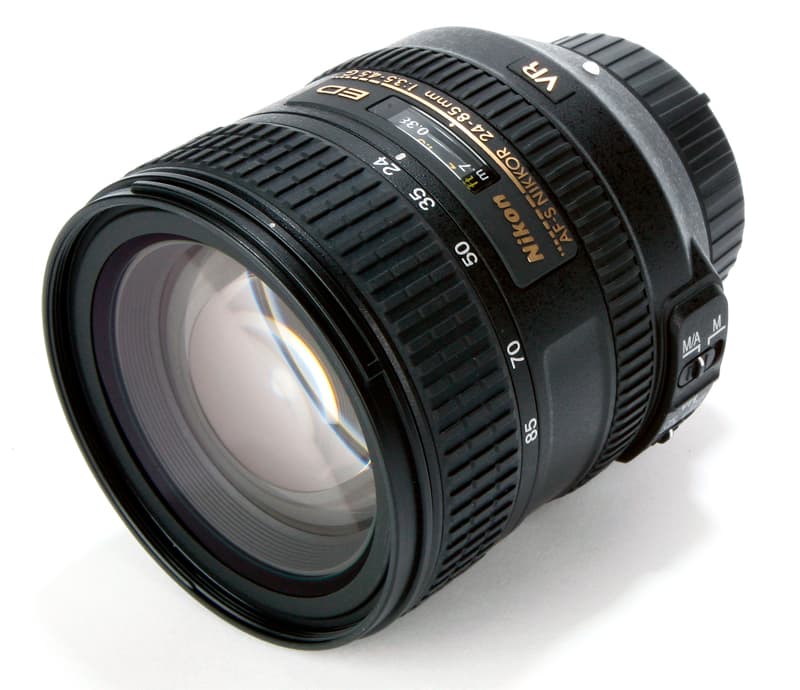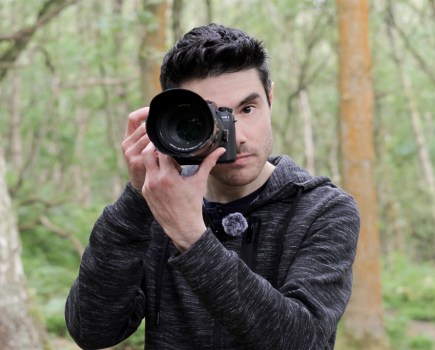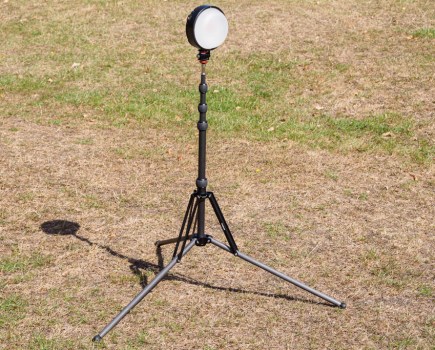AF-S Nikkor 24-85mm f/3.5-4.5G ED VR review – Introduction:
Announced alongside a new 18-300mm f/3.5-5.6G lens, the AF-S Nikkor 24-85mm f/3.5-4.5G ED VR is an intriguing optic. Designed for DSLRs with a full-frame sensor, this budget offering is somewhat in contrast to the expensive professional lenses normally associated with Nikon’s professional DSLR range.
The 24-85mm focal length and f/3.5-4.5 aperture make this lens perfect for everyday use – in effect, a kit lens for a full-frame camera. Yet given the cost of the professional-level Nikon D4, and to a lesser extent the D800, most photographers spending that much money on a camera would be more likely to opt for the tried-and-tested Nikkor 24-70mm f/2.8.
It would seem, then, that Nikon is trying to make entry into its full-frame (FX-format) DSLR range more affordable. The question is, are those who demand the best image quality from their cameras going to be happy with this less expensive lens?
Features
 Constructed from 16 elements in 11 groups, including one extra-low dispersion (ED) and three aspherical elements, the optical design of this lens is new, although the focal range isn’t. Nikon first announced a 24-85mm f/2.8-4D IF lens in 2000, and the lens is still listed on both the UK and US Nikon websites. This older 24-85mm lens doesn’t feature a built-in AF motor, so it cannot autofocus on cameras below the Nikon D7000, although it can be used manually and electronic aperture control does still work.
Constructed from 16 elements in 11 groups, including one extra-low dispersion (ED) and three aspherical elements, the optical design of this lens is new, although the focal range isn’t. Nikon first announced a 24-85mm f/2.8-4D IF lens in 2000, and the lens is still listed on both the UK and US Nikon websites. This older 24-85mm lens doesn’t feature a built-in AF motor, so it cannot autofocus on cameras below the Nikon D7000, although it can be used manually and electronic aperture control does still work.
Image: Chromatic aberrations are visible in raw files, although they are very slight and easily removed
The short-lived Nikkor 24-85mm f/3.5-4G AF-S lens followed in 2002. While this included a built-in AF motor, as part of Nikkor’s G series it lacked an aperture ring. Strangely, this lens was discontinued after four years, presumably because the 35-128mm equivalent focal length when used on a APS-C-sized (DX-format) sensor is not really wide enough for use as an everyday lens, and because those using expensive full-frame DSLRs demanded the higher quality of Nikon’s 24-70mm f/2.8.
The new lens looks similar to the now discontinued 24-85mm f/3.5-4.5, although they are different both optically and in terms of features: the main difference is that the new lens includes Nikon’s Vibration Reduction (VR)technology. The firm claims this will allow the photographer to reduce the given shutter speed by up to 4EV when shooting handheld. This should more than help to make up the 2-3EV difference in maximum aperture between this latest 24-85mm f/3.5-4.5 lens and the original f/2.8-4 version, although obviously the depth of field can’t be accounted for.
Build and handling
There are no real surprises in the design and build of the new 24-85mm f/3.5-4.5 lens. It looks and handles just as you would imagine a kit lens designed for a full-frame Nikon DSLR should. It is slightly wider in diameter than an APS-C kit lens, with a filter thread size of 72mm. This is no doubt to accommodate the larger imaging circle required to cover the larger sensor.
As might be expected at this price, the lens has a largely polycarbonate construction, although it does include a metal lens mount. The fact that the lens isn’t made of metal should be of no concern because the build quality is excellent and there is no wobble between the lens barrels, even at its maximum 85mm zoom extension.
At the end of the lens barrel is the zoom control ring. This isn’t very wide, but the ridged rubber design makes it easy to grip and turn. Just a quarter turn is all that’s required to extend the zoom from 24mm to 85mm. The zoom control is quite firm, and while it is simple to position at the correct point when taking images, it may not be fluid enough for those hoping to zoom while shooting video.
Closer to the lens mount is a thin focus-control ring. I always find these smaller focus ring grips on cheaper Nikkor lenses a little fiddly to use, but that said it is only on rare occasions they will ever be used, particularly on a general-purpose lens such as this. Flicking between manual and automatic focus is simple thanks to a switch on the side of the lens. When in M/A mode the lens will autofocus, but you can manually override this should you wish to fine-tune the focus further.
Below the focus switch sits the Vibration Reduction (VR) control switch, which can be simply turned on or off. I was impressed with the image stabilisation on this lens as it allowed me to shoot as slow as 1/15sec at the 85mm setting and get images that were acceptably sharp, though not perfect. When the stabilisation turns on, it can be seen working through the viewfinder, at which point there is a noticeable difference.

Image: The 24-85mm focal length of the lens is ideal for everyday situations
Image quality

Image: At 24mm f/2.8 vignetting is quite severe, while barrel distortion (centre) and pincushioning (right) will also need correcting
Given its price, the Nikkor 24-85mm f/3.5-4.5G ED VR lens is very sharp. At the 24mm focal length, the lens is able to resolve to around 30 on our test chart when paired with the 24-million-pixel Nikon D3X. This is impressive, and when shooting at 24mm and f/8 it is almost a match for the more expensive Nikkor 24-70mm f/2.8 optic.
As expected, there is some drop off in sharpness when the lens is used with the aperture wide open, and also when apertures of f/16 or smaller are set. However, this gives a very wide range at which the lens is at its optimum, especially given its general-purpose nature. Set the focal length to 85mm and there is another drop in resolution, although our shots show that the lens is still capable of resolving up to around 28 on our chart, which is still very good.
The lens is not without its flaws, however. There is a slight fall-off in resolution towards the edges, although still with an acceptable amount of detail, particularly when you take into consideration the budget nature of the lens. Similarly, some green/magenta chromatic aberrations can be seen on high-contrast edges, although I found that the Nikon D3X corrected these automatically on all the JPEG images. Removing the colour fringing was simple enough in Adobe Camera Raw.
Of more concern is the barrel and pincushion distortion that are very noticeable and which could present a problem to anyone shooting in raw. If shooting architecture or seascapes, it will be beneficial to set up automated lens corrections in raw-conversion software to correct these distortions. For those photographers who use JPEG files, make sure that lens-distortion correction is switched on in-camera. This removes the vast majority of the distortion, althougha slight tweak may still be necessary in editing software for perfection.
Vignetting is also quite harsh when the lens is set to its 24mm wide end, even when the aperture is set to f/8. At other focal lengths vignetting is still noticeable, and it isn’t until 85mm at an aperture of f/8 that it is no longer visible, except on very close inspection. Again, most modern Nikon DSLRs should be able to correct for vignetting automatically. Raw-conversion software, such as DxO Optics Pro or Adobe Photoshop Lightroom, should also be able to automatically correct the vignette once the software has been updated to the latest version that will include data for this new Nikkor lens.

The images show a small section of our resolution chart. All the images in this test were taken with the AF-S Nikkor 24-85mm f/3.5-4.5G ED VR lens using a Nikon D3X, which has a full-frame 24.5-million-pixel sensor. The results are impressive, with the resolution only really decreasing at the 85mm focal length when the smallest aperture settings are used.
To view a large version of the resolution chart, click here
Our verdict
Although the suggested retail price for the Nikkor 24-85mm f/3.5-4.5G ED VR lens is £519, it can be bought for as little as £429. This is a good price for a basic zoom lens designed for a full-frame DSLR. While there are compromises that come with a lens of this price, they are easily overcome, and the centre sharpness of the lens is very good, as is the optical image stabilisation.
Although this optic will not appeal to many professionals, it would seem that Nikon is attempting to make ownership of an FX-format DSLR more affordable. It would therefore be no surprise to see this 24-85mm f/3.5-4.5 optic bundled as a kit lens with an affordable full-frame DSLR in the future.
The 24-85mm f/3.5-4.5G ED VR may not be the greatest zoom lens ever made, but it is a good option for those enthusiasts looking for an affordable lens to pair with their full-frame Nikon DSLR.








